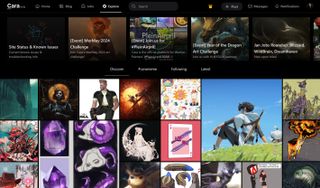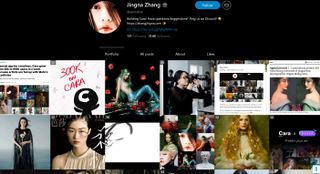Cara app launched in January 2023 but chances are you first heard about it in the last week or so. That’s because in around seven days, it went from having 40,000 users to 700,00 amid the controversy around Instagram using images to train AI. Cara has a no-AI policy, which has led a lot of artists to see it as a potential Instagram alternative, so it may be time to take a look.
Of course, this isn’t the first time we’ve heard talk of an Instagram alternative. And, perhaps with the exception of big hitter TikTok, which Instagram has gone on to imitate in many ways, none has really caught on in a big way. Could Cara be different? Below we round up who Car is for and how it works to help you decide if it’s worth exploring for yourself.
What is Cara app?

Cara is a social media app that’s being billed as an Instagram alternative designed specifically for artists. Available for Android, iOS and as a website, It’s free to use, and it’s become popular largely because of its ban on AI art.
For anyone who’s used Instagram, Cara will feel immediately familiar as the UI is very similar to that of Meta’s platform. Users have a profile displaying a brief bio and their follower and following numbers, they can posts images with captions and hashtags; there’s a ‘Discover’ tab where you can browse other users’ posts, and you can like and comment on posts just like on Instagram.
However, unlike Instagram, Cara focuses specifically on art. There are several differences that reflect this. The grid of highlighted posts on a users’ profile is called a ‘Portfolio’. If you choose to add a post to your portfolio, you can tag a field/medium, project type, category and the software used to create the work. In that sense it feels a bit like a cross between Instagram and ArtStation.
Instagram vs Cara: how do they compare?
The mechanics and UI of the two platforms are very similar, so Cara should be easy for anyone familiar with Instagram to get the hang of. Cara has no passwords: you log in via Google or Apple. And there are some differences in the features and UI that may appeal to artists, such as the ability to change the order of ‘Portfolio’ posts after they’ve been uploaded.
Cara doesn’t support video file formats at the moment, but unlike Instagram, it does support GIFs. Animated GIFs can be displayed directly as covers in users’ feeds, which is something that appeals to animators.
Users can also post text-only posts like on X or Threads in order to start discussions. But most importantly for many of the artists signing up amid the Instagram exodus, the platform aims to filter out images that were created using generative AI. It also promises that it does not train AI models on its users’ content and does not grant permissions to 3rd party companies to train AI using its users’ data.
How does Cara block AI art, and can it prevent scraping?
Cara says it uses a third-party service to automate AI image detection and moderation. It stresses that it does not have the manpower to manually review every image.
As for protecting users’ images from scraping, Cara automatically puts ‘NoAI’ tags on images when they are uploaded. These are intended to tell AI scrapers not to scrape from Cara, but it’s something that depends on good faith and cannot be enforced. As with any publicly accessible online content, unethical actors will be able to scrape images if they want to. Cara recommends use of Glaze, a free tool that allows artists to apply style cloaks to their work to protect it from use in AI training. It’s working on a Glaze integration directly in the app to provide users with a easy way to protect their work before posting.
Can Cara really compete with Instagram?
Cara has grown quickly. It only launched in January 2023, and in the first week of June it went from around 50k to over 700,000k users. However, that’s still tiny compared to Instagram’s two billion. If it retains a specific focus on art, it’s unlikely to become a mainstream platform for popular use.
It’s also unlikely that Cara currently has the resources to maintain a platform with a very large user base. The platform has been crashing due to the increase in traffic, and Cara stresses that it has a very small team. It welcomes donations, but without a more dependable form of monetisation or an angel investor, it could face challenges just to cover the costs of keeping the platform online.
As a relatively small community of artists, Cara currently has both pros and cons. On the plus side, there’s a positive community atmosphere. With no ads and no noisy workout videos or Reels telling you how to make better Reels, artists are more likely to find work that inspires them and other artists to connect with. Some recent newcomers to the platform told me that they find it a “peaceful” place compared to Instagram and enjoy browsing other users’ work.
However, the limited audience makes Cara less appealing for those who want to reach potential customers. With few non-artists on the platform, it’s not likely to be a place where you pick up sales at the moment. Cara does say that it intends to expand to “other art communities and industries” in time, so this could change in the longer term if the app survives.
Who owns Cara app?
Cara app was founded by the Singaporean photographer Jingna Zhang. It launched in January 2023 and is currently run by a small team of volunteers.

Does Cara allow photography?
Yes, it does. Although a glance at the Discover page will show that the majority of content is illustration and animation, Cara does accept photography. Indeed, you can upload a jpg of anything, including screenshots, as long as it doesn’t contain explicit content and wasn’t made with AI. Zhang, is a photographer. She has posted some of her work on her own profile and has said that she hopes to see more photography on the platform.
Is Cara app free?
Yes, Cara app is completely free to use, both via the apps for iOS or Android and the browser-based site. Donations are welcome.
How many users does Cara have?
According to Zhang’s last update, Cara had reached 700,000 users on 6 June. However, its user base has been growing so quickly in recent days that it is very likely that it now has considerably more than that. Zhang reported that the number of uses more than doubled in three days. It also reached the top 5 in the Apple App Store for social networks in the US, passing Twitter, Discord, Reddit, LinkedIn and Messenger for downloads in that period.
Why are artists are leaving Instagram?
Instagram has been facing criticism for several reasons. A lot of people who use the platform to promote their art are becoming disillusioned with the number of adverts and changes in the Instagram algorithm that appear to give more presence to video, resulting in them receiving little reach for posts of their work. Meta has even been testing unskippable Instagram ads for some users.
However, the final straw for many artists was confirmation that Meta is using Instagram images to train its AI image generator. For most users, there’s no way to opt out. And even for those in the European Union, where legislation means that Instagram has to allow an opt out, the platform isn’t making that easy.
Some Instagram users are also getting tired of the AI-generated content on the platform. Instagram has now introduced a ‘Made with AI label’. Users can voluntarily add this to their posts if they want to be honest, and Instagram will automatically add it when it detects the use of AI. However, it’s not clear if it’s yet working as it should. Some photographers have noted that it’s tagged their posts when they have done very minor retouching using AI, such a removing a small imperfection, while some images that appear to be 100% AI seem to be getting through.
